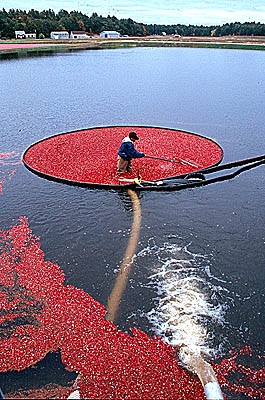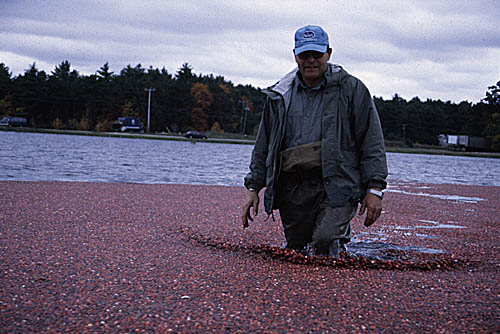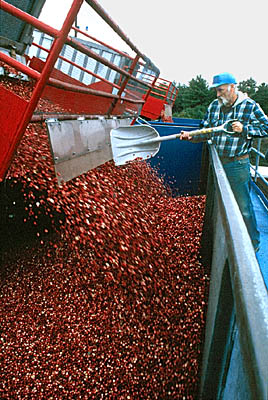
Ever wonder where your OceanSpray cranberry juice comes from? This is a good time of year to find out. Cold weather ripens the cranberries, to make nice dark fruit. Commercial buyers pay a bonus for dark colored fruit. But for cranberry farmers in southeastern Massachusetts, there is a fine balance between cold weather and frost. So the Cape Cod Growers Association issues a frost report.
Cranberries growing in low lying bogs have to be harvested before the first frost comes. Back in October 2000, we visited the Gilmore Cranberry Company bog in South Carver, just after it had been flooded and picked. Susan Gilmore was our guide bogside, while her husband Ben Gilmore worked along with two day laborers from New Bedford.

The berries had been swept to one side of the bog by the wind and then carrolled with “booms.” A tow line with floatation was hooked to the end of the boom; pulling it “corralled” the berries. A hose sucked the berries up along with some water into the truck. The berries were “detrashed” — washed and separated from the chaff and trash. The latter is used for mulch. The clean berries were then loaded into a truck.

Ben Gilmore has donned his waders to help corral the remaining berries. Once the truck was loaded with berries, Ben drove it to the Oceanspray receiving station a few miles away. A few trucks were in line ahead of us. We got permission from an employee in the control house to observe — this is a restricted area. Once on a lift, the truck tilts up to a 90 degree angle, forcing the berries against the back of the truck. A small opening allows the berries spill out — it sounds like a giant rain stike. Once dumped, the load passes by a blower to remove leaves, then is fed onto a conveyor belt into another bin for a final wash to remove the bad fruit and leaves.

And so goes a “wet” harvest of cranberries. The majority of cranberries are harvested this way and will be used for processed food — the juices and sauces. A dry harvest is used for the fresh fruit market and is much more labor intensive. That market is from November to December; the berries don’t keep.
Listen to WBUR’s Robin Young talk with Maggie about her visit to the bog.
Photos by Maggie Holtzberg.
Have a comment? Send me an email: maggie.holtzberg@state.ma.us
